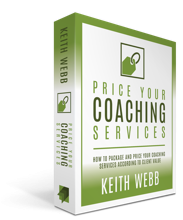How much should I charge? Most new and experienced coaches think in terms of hourly rates and work from there. This is a mistake. Hourly rates make you less attractive to buyers and make it harder to sell your services. I’ll show you how to price your coaching services according to client value.

Hourly rates have a long history. Trading time for money is an easy calculation, easy to measure. I found an hourly rate calculator online for you to play with. Remember, as a general rule one-third of your time must be spent getting new clients, servicing existing clients, and administration. Here’s the calculator.
Most people when playing with the hourly wage calculator underestimate their expenses and overestimate their available time. When you dial it in realistically, the hourly wage you need to make is some ridiculously high amount.
3 Problems With Hourly Rates
Hourly rates are a mistake. Bad for you, bad for your clients. Here’s why:
- Hourly Rates Are About You. The starting point of an Hourly Rate is you – your needs, expenses, and lifestyle. While we care deeply about these things, our customers do not. They are not thinking of your needs. They are thinking of their own expenses and needs. What you charge is an expense to your customer.
- Hourly Rates Sound Expensive. I needed a landscaper to do heavy work in my yard. One guy bid $80 an hour and estimated 5 hours work. $80 an hour sounded really expensive for yard work. Another guy said he’d bring a crew in, do everything we wanted, and finish in one afternoon for $500 for the whole job. Which would you hire? I hired the one afternoon crew for $500 because it sounded like a better value. (Now do the math.)
- Hourly Rates Make You A Commodity. I like shopping at Amazon.com because I can compare prices from different sellers for the same product. When you offer coaching for $50 or $150 an hour, you are tempting people to compare your hourly rate to some other coach’s hourly rate. The customer says, “Another coach I know charges half that. Are you twice as good?” The customer’s focus is on the hourly rate.
Focus On The Value To The Client
People hire you because they believe you can do something for them. Always focus your presentation on client results, not coaching or whatever service you provide. If you use an hourly rate, you are focusing on the process of coaching, not the results clients receive from your coaching. In other words, you’re selling the wrong thing.
- Price According To Client Results. I coached a person fundraising for their on-going nonprofit work. They raised $3,000 in monthly commitments while we coached together. I also coached a CEO, which resulted in a massive increase in profits for the organization. The monetary value of the results from these two clients were very different. I want to be compensated according to that value.
- Price According To Difficulty. Determining the value of a happy marriage, fulfillment at work, or reduced stress is difficult. This is why so-called Life Coaches are paid on average half as much as Executive Coaches. Yet, these intangible things are very valuable to clients. What makes them valuable is how difficult they are to achieve. If you can actually deliver these result, then your price can reflect that difficulty.
- Price According To The Client’s Ability To Pay. Some types of clients will be willing to pay more than others. I work a lot with nonprofit organizations. The amount a field staff is willing to pay for coaching and what an executive is willing to pay are very different. It’s the same difference between small business owners and corporate executives. Sometimes you can offer all the results in the world, but your customer isn’t willing or able to pay for it. You may need to adjust your fee expectations or find a different type of client who will pay what you want to charge.
- Price According To Expertise You Provide. There’s an old saying, “The first sale you make is to the person in the mirror.” How you view yourself, the expertise you bring, and the results you will achieve with clients, will show up in your fees. I remember not too long ago I cringed at charging the equivalent of $100 an appointment. Now, after seeing the changes clients have made in their organization and personal life, I see that amount as a bargain.
- Price According To The Client’s Other Options. If your clients were to attend a conference in hopes of learning what they needed to solve their problem or reach their goal, what would they spend? Think of the conference fee, travel, lodging, food, etc. $1500? $2500? And how much would that conference actually help them? Usually not much. With coaching, it’s 100% about the client. Their needs. Their learning. Their application. And they can do it while remaining engaged in their business. What is that worth?
 Price Your Coaching Services
Price Your Coaching ServicesIn this online course, I’ll show you how to package and price your coaching services for compelling client value. I will personally walk you through 8 practical and easy-to-follow modules, including downloadable videos, audio recordings, worksheets, and PDFs of every presentation. Get more clients now.
Create Packages Based On Client Results
Identify common challenges or goals of the type of client you work with and develop packages to accomplish them. Price the package according to the value of the result.
- Describe the results. For example, “We will increase your leadership effectiveness. This highly personalized process begins by identifying your best leadership practices and your challenges. Where you’ve been stuck, we’ll move you forward. Where you have blind spots, I’ll help you see. Where you’ve been frustrated, we’ll get at the root causes and find solutions.” When you speak with a potential client, you can use questions from my article Don’t Sell Coaching, Sell Client Results.
- Bundle several types of tools together. For example, “We will begin and end with robust leadership assessment, this way we can identify specific needs and measure your progress. Each month, for six months, we’ll have two calls together. On those calls you’ll set your own action steps for implementation. These assignments are due before the next call. After we determine your specific objectives, I will provide you a list of resources that may help you further. In addition, I will be available to you anytime through email.” This description of services sounds a lot better than “we’ll coach twice a month”. It’s also a more complete process.
- Price according to the package. For the package above you might charge $2,500 to a small business owner, but $6,000 to a corporate executive. Or you could charge on a sliding scale, say, half a month of the client’s salary. Or sell the whole package, but price it in monthly installments, for example $500 a month.
Moving from an hourly rate to packages based on client results will be much more attractive to your clients. You will stand out from the per-session crowd. Clients will better understand “what’s in it for them” and compare the value of those results to the price of your service.
Question: How do you communicate and price according to client value? You can leave a comment by clicking here.


Keith, this is Awesome!, Briliant, Insightful, Bodacious, and Koolio (not a word). I loved your post and the transformation it made in my mindset. I had it alllllll wrong. You’ve sort-of slapped me upside my head with this integral piece of wisdom. Thanks, thanks, and THANKS.
Question:
1. How does a coach decide on how many sessions (hours…opps sorry) a client will need to grab the ‘results”?
2. How does one measure that success and be able to explain the results system to the client?
I see many of the greats (you included) charge by year. They charge premium 6-figure rates per year (Steve Chandler, Marshall Goldsmith, Steve Hardision, Anthony Robbins, etc.). How does one move to that mindset/experience shift, comfortably?
Thanks
Bill, glad this helps! The number of sessions in your agreement comes from your experience. Clients need more than just a mindset shift (and this takes time too), they need to get into action and be supported there. So, 4-6 months minimum is not unrealistic.
Regarding describing and measuring results, treat your coaching like how you would describe a workshop or program. For example, a friend of mine is offering coaching to support people to quit smoking. He lists tangible results. You can compare the value of those results to other means of achieving them and set price accordingly.
For more tangible business results, look at Lisa Ann Edwards’ book, Measuring the Success of Coaching: A Step-by-Step Guide for Measuring Impact and Calculating ROI. http://amzn.to/1UTbCzP
Thanks Keith. I literally just found you. I was researching growth in my biz and came across you. That’s gotta be divine-lead. Why? Because we mirror paths. I’ve worked in Asia for over 25-years as well. Currently doing stuff in Singapore. Okay, back to the point. Thanks for having the answers to tons of my challenges. And a super-thanks for peppering your replies with links and other sources, when you don’t have all the answers. That shows true strength. Your Blog and site are a tremendous guide. I’m going in to read more of your posts. So, be ready for multiple Bill-comments under each of yours. Darn glad I discovered an extraordinary coach.
I’m thinking of using this for personal branding and social media coaching. Do you think these methods would work the same in the industry I’m in?
The principles apply to any industry. Sell the value, the results, not your time.
Hi, Keith! Thanks for providing this information. I had a feeling creating custom packages was the way to go and your article brought to life all the reason I wasn’t able to articulate until now. Thanks!
Great advice, thank you
Hi Keith,
L-O-V-E the focus on the customer’s problem. I come from a Lean Startup background and am new to coaching. It wasn’t until I found this post that how to price my coaching offering became obvious for me … it’s all about the below graphic. Duh, I knew that already from how I help my consulting clients. Now I will simply apply it to my coaching practice thanks to you sharing your wisdom!
https://uploads.disquscdn.com/images/c9d9c7ebb4ad5898e40944cf9aefd1816543fd53d5c3483d312f3c9f3e998f48.png
Hey there. Your article is very helpful and detailed at the same time. Now I learned the importance of pricing a coaching service based on value. As a coach, I learned that the real value that I offer is in the result that I am able to help my clients get. That’s infinitely more value than the hours that I put in to help them get that result. So, if hourly pricing is not the way to go, what other pricing strategy options can you suggest?
Hi Fraser, What to do instead of hourly rates? Use the 3 ideas from the end of the article. Price according to results, create a package with other things in it and price together, or price monthly. For a “quit smoking” coaching package, you could price for $3000 for up to 6 months of coaching appointments, weekly emails (pre-written and sent automatically with inspiring info), and something else. The idea is that most of the people who do that package see the results they are looking for within that time frame.